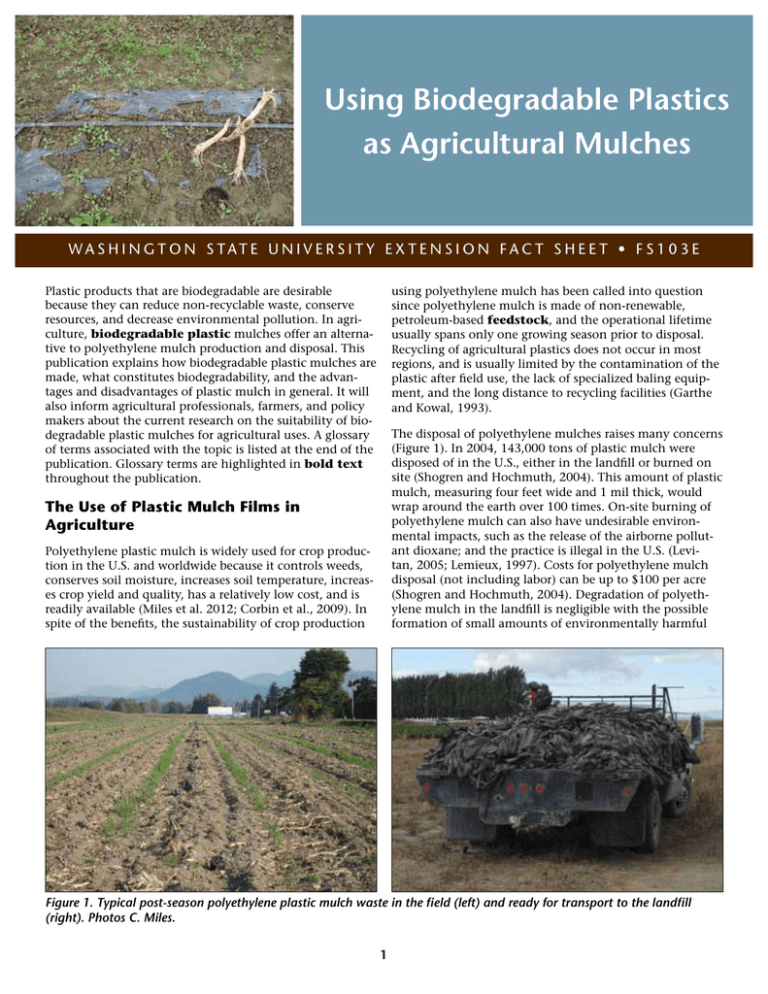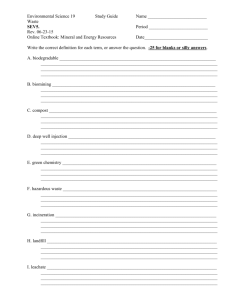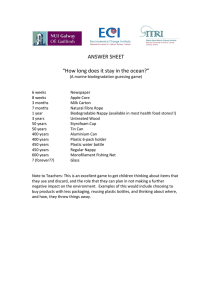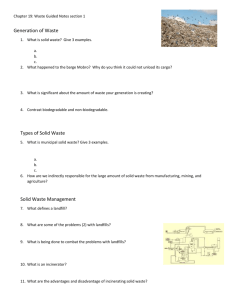Using Biodegradable Plastics as Agricultural Mulches
advertisement

Using Biodegradable Plastics as Agricultural Mulches W a s h i n g t o n s t a t e u n i v e r s i t y e x t e n s i o n f a c t s h e e t • FS 1 0 3 E Plastic products that are biodegradable are desirable because they can reduce non-recyclable waste, conserve resources, and decrease environmental pollution. In agriculture, biodegradable plastic mulches offer an alternative to polyethylene mulch production and disposal. This publication explains how biodegradable plastic mulches are made, what constitutes biodegradability, and the advantages and disadvantages of plastic mulch in general. It will also inform agricultural professionals, farmers, and policy makers about the current research on the suitability of biodegradable plastic mulches for agricultural uses. A glossary of terms associated with the topic is listed at the end of the publication. Glossary terms are highlighted in bold text throughout the publication. using polyethylene mulch has been called into question since polyethylene mulch is made of non-renewable, petroleum-based feedstock, and the operational lifetime usually spans only one growing season prior to disposal. Recycling of agricultural plastics does not occur in most regions, and is usually limited by the contamination of the plastic after field use, the lack of specialized baling equipment, and the long distance to recycling facilities (Garthe and Kowal, 1993). The disposal of polyethylene mulches raises many concerns (Figure 1). In 2004, 143,000 tons of plastic mulch were disposed of in the U.S., either in the landfill or burned on site (Shogren and Hochmuth, 2004). This amount of plastic mulch, measuring four feet wide and 1 mil thick, would wrap around the earth over 100 times. On-site burning of polyethylene mulch can also have undesirable environmental impacts, such as the release of the airborne pollutant dioxane; and the practice is illegal in the U.S. (Levitan, 2005; Lemieux, 1997). Costs for polyethylene mulch disposal (not including labor) can be up to $100 per acre (Shogren and Hochmuth, 2004). Degradation of polyethylene mulch in the landfill is negligible with the possible formation of small amounts of environmentally harmful The Use of Plastic Mulch Films in Agriculture Polyethylene plastic mulch is widely used for crop production in the U.S. and worldwide because it controls weeds, conserves soil moisture, increases soil temperature, increases crop yield and quality, has a relatively low cost, and is readily available (Miles et al. 2012; Corbin et al., 2009). In spite of the benefits, the sustainability of crop production Figure 1. Typical post-season polyethylene plastic mulch waste in the field (left) and ready for transport to the landfill (right). Photos C. Miles. 1 chemical products such as aldehydes and ketones (Hakkarainen and Albertsson, 2004). “green” polymers because they are made from renewable resources in a one-step process through bacterial fermentation of sugars and/or lipids (Kaihara et al., 2005; Posada et al., 2011; Hayes et al., 2012). PHA polymers may be produced from microbes or plants, but currently, microbes are the primary source (Keshavarz and Roy, 2010). To be a viable alternative, biodegradable plastic mulch must perform comparably to polyethylene mulch in crop production, especially in regards to durability and ability to block light to prevent weed germination. Once the cropping season is complete, the biodegradable mulch is incorporated into the soil where it should rapidly degrade, that is, it should lose mechanical strength and undergo a reduction in the degree of polymerization (Figure 2). The use of biodegradable mulches could save significant labor and disposal costs, conserve resources, and decrease pollution (Smith et al., 2008). Nonwovens are manufactured sheets, webs or bats of directionally or randomly oriented fibers or filaments, bonded together. Nonwovens may be manufactured by spunbond or meltblown processes. In the spunbond process, polymers are first melted and then extruded through spinnerets, producing filaments which are cooled and laid down on a conveyer belt to form a web. In the meltblown process, polymers are extruded through a die or spinneret, and filaments are stretched, dispersed, cooled, and then collected on a roll. Generally, meltblown nonwovens have smaller fiber sizes and are weaker in mechanical strength than spunbond nonwovens (Hayes et al., 2012). How Biodegradable Plastic Mulches are Made Most biodegradable plastic mulches that are currently available commercially are made from plant starch. Agricultural films made of starch are prepared using conventional plastics processing technology. However, due to the poor mechanical properties of starch, including its brittleness, it must be blended with other polymers and/or plasticizers. Products currently on the market that are derived from or blended with plant starch include BiosafeTM (Xinfu Pharmaceutical Co., China), Eastar BioTM (Novamont, Italy), Eco-Flex® (BASF, Germany), Ingeo® (NatureWorks, USA), Mater-Bi® (Novamont, Italy) and Paragon (Avebe, Netherlands) (Hayes et al., 2012). Some processes that are used to form biodegradable polymers use additives. These additives include nucleating agents (chemical substances incorporated in plastics for the growth of crystals in the polymer melt), plasticizers, coloring agents, performance additives, and/or lubricants to improve the mechanical properties of the plastic. The environmental impact of many additives can be a major concern. Additionally, some additives are derived from petroleum, and are considered synthetics by National Organic Program (NOP) standards, thus preventing their certification for use in U.S. organic agriculture (Hayes et al., 2012). Furthermore, the NOP considers PLA to be synthetic because PLA is chemically polymerized (Briassoulis and Dejean, 2010). While the PHA polymer is made directly by microorganisms in the fermentation process (thereby considered “natural” by the NOP), it is highly crystalline, making the end product more brittle and less desirable, unless blended with PLA (Hayes et al., 2012). Two polymers that may have a role in biodegradable plastic mulches in the future are polylactic acid (PLA) and polyhydroxyalkanoate (PHA). PLA is a highly versatile, biodegradable polyester derived from 100% renewable resources such as corn and sugar beet starch, and offers great promise in a wide range of commodity applications (Drumright et al., 2000). Starch is converted by microorganisms into lactic acid through fermentation. Lactic acid molecules are then linked together into long chains called polymers. PLA is a relatively inexpensive biopolymer to manufacture and can be produced in large quantities. The PLA polymer is highly attractive for biological and medical applications because it can be spun into filaments that can be used to make textiles or films (Gupta et al., 2007). PHAs are promising biodegradable plastics that have been highlighted as What Constitutes Biodegradability Many agricultural plastics are advertised as biodegradable; however such claims need to be evaluated carefully. For a manufacturer to employ the claim of biodegradability, a set of specified standards need to be met. ASTM International (formerly known as the American Society for Testing and Figure 2. Starch-based biodegradable plastic mulch (BioAgri) in experimental field plots prior to harvest (left), one year later on soil surface (center), and 9 months post incorporation (right). Photos J. Cowan (left) and C. Miles. 2 Materials) has prepared a series of standards for compostable plastics to measure biodegradability under industrial composting conditions, referred to as ASTM D6400. There is a growing contingency of manufacturers and farmers who would like for this interpretation of the NOP standards to be revised so that biodegradable plastic mulches are included on the national list of allowable synthetic substances. As a precedent, the organic standards in Canada and the European Union (E.U.) allow some use of currently available biodegradable plastic mulches. In 2012, the Biodegradable Products Institute (BPI) petitioned the NOP to allow the addition of biodegradable plastic mulch currently allowed in Canada and the E.U. under section 205.206 (c) of the National Organic Standards Biodegradable Plastic Mulch Made from Bioplastics: without removal at the end of the growing or harvest season (BPI, 2012). The ASTM D6400 specification employs several ASTM standardized tests, such as the measure of the inherent biodegradability of the plastic material via ASTM D5988-03. This test allows for the microbial conversion of the plastic’s carbon (C) atoms to carbon dioxide, measured as a function of time. A standard contained in ASTM D6400 specifies that 90% of carbon atoms must be mineralized, that is, converted to carbon dioxide (CO2), in 180 days (ASTM, 2003). In the field or laboratory, CO2 release is measured through the actions of micro-organisms which naturally occur in the system being tested. An additional requirement to meet the organic standards is that feedstocks, such as corn, used to produce the polymer, must be free of genetically modified organisms (GMOs). Similarly, any polymer made from microbial fermentation, such as PHA, must be produced by GMOfree organisms. Biodegradable plastic mulch manufacturers must certify that their feedstocks and microbial fermentation processes are GMO-free; however, there is no available test to verify GMO byproducts in the final product. While there is no specific NOP policy on GMOs in biodegradable plastic feedstock, the NOP has developed an ad-hoc committee to clarify the GMO issue. To evaluate the results of standardized biodegradability tests, three criteria must be considered: (1) the constituents and environmental conditions of the system—composting, anaerobic digester, soil, marine, etc., (2) the time frame—180 to 365 days is considered optimal for plastic biodegradability in composting, and (3) the fraction of carbon atoms that are fully mineralized by microorganisms. Many types of mulch claiming to be biodegradable are actually compostable, and fulfill the requirements of ASTM D6400, or related standards. Moreover, no standard currently exists for measuring the biodegradability of plastics buried in soil under field soil conditions. To meet this need for measuring biodegradability within the soil, ASTM is developing a standard through a specification (Work Item 29802) entitled “Aerobically Biodegradable Plastics in the Soil Environment” (Ramani Narayan, ASTM Fellow, personal communication). In this new standard, biodegradable mulches must break down into CO2, water and environmentally benign substances within one or two years, leaving no harmful residues. The ability of existing and emerging biodegradable plastic mulch products to meet these criteria in the soil environment is still being researched (Harding et al., 2007; Hayes et al., 2012; Miles et al., 2012; Hoshino et al., 2007; Kapanen et al., 2008; Kijchavengkul et al., 2008; Kyrikou and Briassoulis, 2007; Mohee and Unmar, 2007; Tachibana et al., 2009; Wadsworth et al., 2009). Another requirement for use in certified organic production is that the resins and any inert additives used in the processing and formulation of biodegradable plastic mulch products must be identified and compared to the national list of allowable substances. The designation of ingredients as proprietary is not adequate for the NOSB to review them for approval. Finally, any biodegradable plastic mulch that may eventually be approved for use by the NOSB must completely biodegrade into carbon dioxide, water, and microbial biomass within a reasonable timeframe without forming harmful residues or by-products. Sufficient data will be needed to show that each type of biodegradable mulch is truly biodegradable in an agricultural system. Biodegradable Plastic Mulch Restrictions in Certified Organic Production Current and Future Prospects for Biodegradable Plastic Mulch Certified organic farmers are currently allowed to use polyethylene mulch if it is removed at the end of the growing season. To some, such use represents a contradiction between the resource conservation goals of sustainable, organic agriculture, and the waste generated from the use of polyethylene mulch. In the U.S., organic crop producers are not able to use currently available biodegradable plastic mulch products because these products do not conform to current NOP standards. To be acceptable for organic production, biodegradable plastic mulch must be entirely composed of constituents derived from natural resources (bio-based), cannot contain synthetics such as petroleumderived ingredients or additives, and cannot be chemically modified during the manufacturing process (NOS, 2012; Corbin et al., 2009). While biodegradable plastic mulches are currently available, they are not allowed for use in certified organic crop production in the U.S.; however, research and development in the area continues (Hayes et al., 2012; Miles et al., 2012; Kapanen et al., 2008; Kijchavengkul et al., 2008). A study is underway at Washington State University, Texas Tech University, and the University of Tennessee at Knoxville to assess the impact of soil incorporation on mulch biodegradation and soil quality. In this study, mesh bags containing a 4-inch by 4-inch piece of biodegradable plastic mulch (weathered in the field for one growing season) and 300 to 400 grams of native agricultural soil were buried 4 inches deep in field plots at the three locations. At each location, one mesh bag was removed from the soil every 6 months for 24 months, and the mulch was evaluated for percent 3 Glossary surface area degradation, and the soil was assessed for potential changes in quality (Figure 3). Aldehydes. Compounds RC(=O)H , in which a carbonyl group (a functional group composed of a carbon atom double-bonded to an oxygen atom) is bonded to one hydrogen atom and to one R group or side chain (IUPAC, 1997). Five soil quality indicators were selected from the Soil Management Assessment Framework (SMAF 2011) to assess potential changes in physical, chemical, and biological soil properties for each mulch-soil sample. The indicators included: total soil organic carbon, microbial biomass carbon, β-glucosidase (an enzyme associated with decomposition, and an energy source for microbes), soil pH, and electrical conductivity. After 6 and 12 months burial in the field plots, there were no differences in the Soil Quality Index (SQI) among any of the mulch-soil samples at all three locations when compared to a non-mulch (bare ground) control. After 18 months, surface area degradation of biodegradable mulches ranged from 0% at Mount Vernon, WA to nearly 90% at Lubbock, TX. Additionally, at all three locations, tomatoes grown with biodegradable plastic mulch produced equivalent yields as compared to the standard polyethylene mulch. Biodegradable plastic. Degradable plastic in which the degradation results from the action of naturally occurring microorganisms such as bacteria, fungi, and algae (ASTM, 2011; 2004). Bio-based. Commercial or industrial products (other than food or feed) that are composed in whole, or in significant part, of biological products, or renewable domestic agricultural materials (including plant, animal, and marine materials) or forestry materials (Biobased US, 2007). Bioplastics. Form of plastics derived from renewable biomass sources, such as vegetable fats, oils or starches. While there are still much more data to be collected and analyzed in this on-going study, there is evidence of incomplete surface area biodegradation of these biodegradable plastic mulches after 18 months of burial in the field. Similar studies should be conducted with all new potentially biodegradable plastic mulches to ensure they will biodegrade in the soil within a reasonable time frame (18-24 months), and there are no harmful residues, fragments or by-products remaining in the soil which could negatively impact soil and/or plant health in any type of crop production system. Feedstock. Raw material that is used to supply, or fuel, a process. Fermentation. The process in which cells (microorganisms, plant or animal cells) are cultured in a bioreactor in liquid or solid medium to convert organic substances into biomass (growth) or into products (IUPAC, 1997). Genetically Modified Organism (GMO). An organism whose genetic material has been altered using genetic engineering techniques; also referred to as a genetically engineered organism (GEO). Inert. Stable and unreactive under specified conditions (IUPAC, 1997). Ketones. Compounds in which a carbonyl group (a functional group composed of a carbon atom double-bonded to an oxygen atom) is bonded to two carbon atoms. (IUPAC, 1997). Microbial biomass. Material produced by the growth of microorganisms (IUPAC, 1997). Mineralization. Microbial conversion of organic matter into inorganic substances, such as water and carbon dioxide (Guggenberger, 2005). Polymer. A molecule of high relative molecular mass, the structure of which essentially comprises the multiple repetition of units derived, actually or conceptually, from molecules of low relative molecular mass (IUPAC, 1997). Polymerization. Any process in which relatively small molecules, called monomers, combine chemically to produce a very large chainlike or network molecule, called a polymer (Encyclopedia Britannica 2012). Figure 3. Sample of starch-based biodegradable plastic mulch (BioAgri) recovered after six months burial in the field at Knoxville. Photo J. Moore-Kucera. Synthetic material. (according to the USDA NOSB) A substance that is formulated or manufactured by a chemical 4 Hakkarainen, M.; Albertsson, A.-C. 2004. Environmental degradation of polyethylene. Adv. Polym. Sci., 169 (Long-Term Properties of Polyolefins), 177-199. process or by a process that chemically changes a substance extracted from naturally occurring plant, animal, or mineral sources, except that such term shall not apply to substances created by naturally occurring biological processes (Sullivan, 2011). Harding, K. G., J. S. Dennis, H. von Blotnitz & S. T. L. Harrison 2007. Environmental Analysis of Plastic Production Processes: Comparing Petroleum-Based Polypropylene and Polyethylene with Biologically-Based Poly-B-Hydroxybutyric Acid Using Life Cycle Analysis. Journal of Biotechnology 130, 57-66. References ASTM D 5988-03. 2003. Standard test method for determining aerobic biodegradation in soil of plastic materials or residual plastic materials after composting. ASTM International, West Conshohocken, PA USA. Hayes, D. G., S. Dharmalingam, L. C. Wadsworth, K. K. Leonas, C. A. Miles & D. A. Inglis. 2012. Biodegradable Agricultural Mulches Derived from Biopolymers. In Degradable Polymers and Materials, Principles and Practice, ed. A. I. Kishan C. Khemani, Carmen Scholz, University of Alabama at Huntsville. ACS Books. ASTM D6400. 2004. International Standard specification for compostable plastics. ASTM International, West Conshohocken, PA USA. ASTM D883. 2011. International Standard terminology relating to plastics. ASTM International, West Conshohocken, PA USA. Hochmuth, R. C. 2001. Field evaluation of watermelon produced on paper mulch coated with polymerized vegetable oil. North Florida Res. and Educ. Ctr. Suwanee Valley, FL. 23 Feb. 2007. http://nfrec-sv.ifas.ufl.edu/reports_mulch. htm. Biobased US. 2007. What are Bio-Based Products? http://www.biobased.us/biobased.html. Hoshino, A., M. Tsuji, M. Momochi, A. Mizutani, H. Sawada, S. Kohnami, H. Nakagomi, M. Ito, H. Saida, M. Ohnishi, M. Hirata, M. Kunioka, M. Funabash & S. Uematsu 2007. Study of the determination of the ultimate aerobic biodegradability of plastic materials under controlled composting conditions. Journal of Polymers and the Environment 15, 275-280. BPI 2012. Support the BPI’s Biodegradable Mulch Film Petition. Biodegradable Products Institute, Inc. New York, NY. http://www.bpiworld.org/mulchpetition. August 28, 2012. Briassoulis, D.; Dejean, C. 2010. Critical Review of Norms and Standards for Biodegradable Agricultural Plastics Part I: Biodegradation in Soil. J. Polym. Environ. 18 (3), 384400. IUPAC. 1997. Compendium of Chemical Terminology, 2nd ed. (the “Gold Book”). Compiled by A. D. McNaught and A. Wilkinson. Blackwell Scientific Publications, Oxford. http://goldbook.iupac.org 2006. Created by M. Nic, J. Jirat, B. Kosata; updates compiled by A. Jenkins. ISBN 0-9678550-9-8. doi:10.1351/goldbook. Corbin, A., Miles, C., Hayes, D., Dorgan, J., and Roozen, J. July 25–28, 2009. Suitability of Biodegradable Plastic Mulches In Certified Organic Production. American Society of Horticulture Conference, St. Louis, Missouri. http://ashs.org/db/horttalks/detail.lasso?id=684. Kaihara, S., Y. Osanai, K. Nishikawa, K. Toshima, Y. Doi & S. Matsumura 2005. Enzymatic transformation of bacterial polyhydroxyalkanoates into repolymerizable oligomers directed towards chemical recycling. Macromolecular Bioscience 5, 644-652. Daintith, J., ed. 2008. A Dictionary of chemistry. 6th ed. New York, Oxford University Press. 584 p. QD5.D4985. Drumright, R. E., P. R. Gruber & D. E. Henton 2000. Polylactic acid technology. Advanced Materials 12, 1841-1846. Encyclopedia Britannica 2012. Encyclopedia Britannica Online Academic Edition. Encyclopedia Britannica Inc. Web. 18 Sep. 2012. Kapanen, A., E. Schettini, G. Vox & M. Itavaara 2008. Performance and Environmental Impact of Biodegradable Films in Agriculture: A Field Study on Protected Cultivation. Journal of Polymers and the Environment 16, 109-122. Garthe, J.W. and P.D. Kowal. 1993. Recycling used agricultural plastics. Penn State Fact Sheet C-8. http://pubs.cas. psu.edu/freepubs/pdfs/C8.pdf. May 23, 2012. Keshavarz, T. & I. Roy 2010. Polyhydroxyalkanoates: bioplastics with a green agenda. Current Opinion in Microbiology 13, 321-326. Guggenberger, G. 2005. Microorganisms and soil genesis. In Microorganisms in soils: roles in genesis and functions. Buscot, F.; Varma, A., Eds. Springer-Verlag: Berlin; pp 85-106. Kijchavengkul, T., R. Auras, M. Rubino, M. Ngouajio & R. T. Fernandez 2008. Assessment of aliphatic-aromatic copolyester biodegradable mulch films. Part I: Field study. Chemosphere 71, 942-953. Gupta, B., N. Revagade & J. Hilborn 2007. Poly(lactic acid) fiber: An overview. Progress in Polymer Science 32, 455482. Kyrikou, I. & D. Briassoulis 2007. Biodegradation of agricultural plastic films: A critical review. Journal of Polymers and the Environment 15, 125-150. 5 Shogren, R.L. and Hochmuth, R.C., 2004. Field evaluation of watermelon grown on paper-polymerized vegetable oil mulches. HortScience 39:1588-1591. Lemieux, P. M. 1997. Evaluation of emissions from the open burning of household waste in barrels. US Environmental Protection Agency Report 600/R-97-134a; Washington, DC; p 70. SMAF 2011. Soil Quality Indicators: Measures of Soil Functional State. Soil Quality for Environmental Health. http://soilquality.org/. August 30, 2012. Levitan, L. 2005. Reducing dioxin emissions by recycling agricultural plastics: Creating a viable alternative to open burning. In Great Lakes Regional Pollution Prevention Roundtable, New York. Smith, B. R., L. C. Wadsworth, M. G. Kamath, A. Wszelaki & C. E. Sams. 2008. Development of Next Generation Biodegradable Mulch Nonwovens to Replace Polyethylene Plastic. In International Conference on Sustainable Textiles (ICST 08). Wuxi, China (CD ROM). Miles, C., R. Wallace, A. Wszelaki, J. Martin, J. Cowan, T. Walters, and D. Inglis. 2012. Durability of potentially biodegradable alternatives to plastic mulch in three tomato production regions. HortScience 47(9):1270-1277. Sullivan, D. 2011. Compostable plastics and organic farming. BioCycle (3), 36-41. Mohee, R. & G. Unmar 2007. Determining biodegradability of plastic materials under controlled and natural composting environments. Waste Management 27, 1486-1493. Tachibana, Y., T. Maeda, O. Ito, Y. Maeda & M. Kunioka 2009. Utilization of a Biodegradable Mulch Sheet Produced from Poly(Lactic Acid)/Ecoflex®/Modified Starch in Mandarin Orange Groves. International Journal of Molecular Sciences 10, 3599-3615. National Organic Standards 2012. § 205.206 Crop pest, weed, and disease management practice standard. § 205.601(b)(2)(i-ii) Synthetic substances allowed for use in organic crop production. http://www.ams.usda.gov/ AMSv1.0/nop. Wadsworth, L. C., A. Wszelaki, D. G. Hayes & B. R. Smith. 2009. Development of Enhanced Biodegradable Mulch Nonwovens to Replace Plastic Films. AATCC International Conference, Myrtle Beach, SC, March 10-12, 2009. Posada, J. A.; Naranjo, J. M.; Lopez, J. A.; Higuita, J. C.; Cardona, C. A. 2011. Design and analysis of poly-3-hydroxybutyrate production processes from crude glycerol. Process Biochem. (Amsterdam, Neth.) 46 (1), 310-317. By Andrew Corbin, Agriculture and Natural Resources Faculty, WSU Snohomish County Extension, Everett, WA; Jeremy Cowan, Ph.D. Candidate, Department of Horticulture, WSU Mount Vernon Northwestern Washington Research and Extension Center; Carol Miles, Vegetable Specialist, Department of Horticulture and Landscape Architecture, WSU Mount Vernon Northwestern Washington Research and Extension Center; Doug Hayes, Department of Biosystems’ Engineering and Soil Science, University of Tennessee-Knoxville; John Dorgan, Site Director, Colorado Center for Biofuels and Biorefining Department of Chemical Engineering, Colorado School of Mines; and Debra Inglis, Professor, Department of Plant Pathology, WSU Mount Vernon Northwestern Washington Research and Extension Center. Copyright 2013 Washington State University WSU Extension bulletins contain material written and produced for public distribution. Alternate formats of our educational materials are available upon request for persons with disabilities. Please contact Washington State University Extension for more information. You may download copies of this and other publications from WSU Extension at http://pubs.wsu.edu. Issued by Washington State University Extension and the U.S. Department of Agriculture in furtherance of the Acts of May 8 and June 30, 1914. Extension programs and policies are consistent with federal and state laws and regulations on nondiscrimination regarding race, sex, religion, age, color, creed, and national or ethnic origin; physical, mental, or sensory disability; marital status or sexual orientation; and status as a Vietnam-era or disabled veteran. Evidence of noncompliance may be reported through your local WSU Extension office. Trade names have been used to simplify information; no endorsement is intended. Published January 2013. FS103E 6






